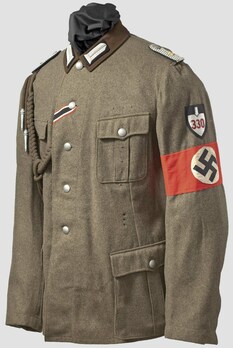RAD Tunic M39 Closed-Neck
SKU: 80.GOR.02.01.01.01.005
Estimated market value:

Estimated market value:
Attributes
History
The RAD (Reichsarbeitsdienst = Reich Labour Service) was officially established on June 26, 1935 as the sole, and compulsory, labour service of Germany. Its purposes were to help the economy, curb unemployment, and indoctrinate its members with the NSDAP ideology, as well as play its part in militarising the German population.
The FAD (Freiwilliger Arbeitsdienst = Voluntary Labour Service) was the precursor of the RAD in the early 1930s. Official uniform regulations were first introduced on October 1, 1933, with modifications made in July 1934. It is also known as NSAD (Nationalsozialistischer Arbeitsdienst = National Socialist Labour Service).
The earliest uniforms were a not entirely successful attempt at standardisation. They gave way to a second wave of FAD uniforms that, when the RAD was established, experienced no significant changes.
The earliest tunic of the FAD is dark brown, darker than the one that was implemented next. It has two side pockets and was worn buttoned to the neck.
The first tunic was replaced by an earth-brown model with a dark brown collar. This tunic was worn by members of the FAD as well as later by those of the RAD. It is single-breasted and was worn with open collar. There are two pleated breast pockets and two unpleated side pockets. It has a four front button closure. All buttons are made from aluminum, except for General ranks who wore gold-coloured buttons.
A second pattern was introduced in 1935 and worn until 1937 by all ranks. It is still earth-brown with a dark brown collar, and was worn open at the neck. There are two pleated breast pockets with a buttoned straight-edge flap and two concealed hip pockets with a slanted buttoned flap. The tunic is single breasted and has four buttons. On the Officer version are turned-back cuffs while EM ranks wore no cuffs, but a buttoned slash at the rear seam instead.
A third pattern was introduced in 1937 and worn until 1938. The only difference to the 2nd pattern is that the EM ranks tunic now has straight flaps at the hip pockets.
Another pattern was introduced in 1939, the 1939 Open-Neck pattern. This one is more a blouse than a tunic and was used for informal occasions. It has two straight-edged pleated patch hip pockets with buttoned flaps. As of April 29, 1942 NCOs wore aluminum tress about the outer edge of the collar.
A complimentary yet opposite pattern introduced in August of that same year is the 1939 Closed-Neck pattern. It has five buttons and pleated patch side pockets.
Another tunic version is the White Summer Tunic for Leaders. It is similar to the Closed-Neck version, but has six buttons, no turn-up cuffs, and a stand-up collar. No collar patches were worn on it.
A new Leader Tunic was introduced in August 1939, to be adopted by May 1940. It differed from the standard tunic in that it has seven buttons down the front, deep turned-up cuffs, and two waist line buttons on the reverse to use as a belt ramp. There are two pleated breast pockets, two inside side breast pockets, and the regular tunic’s hip pockets. It was worn by Senior NCOs and above as a camp duty and walking out tunic. Generalarbeitsführer rank and above have black piping on the collar edge, around the turn-up of the cuffs, and down the front edge.
Another version, the 1939 Informal and Office Tunic pattern for Officers, was introduced that same year. It is single-breasted with an open neck, five buttons, a dark brown collar, two pleated breast pockets, and two concealed hip pockets with straight buttoned flaps.

Versions
$1,000 USD


Comments
Sign in to comment and reply.


Scroll Top